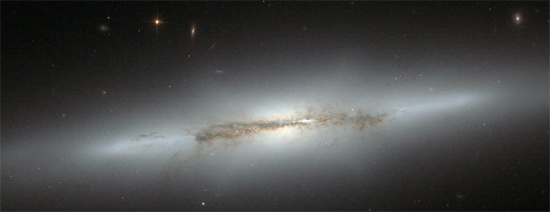
Edge-on galaxy NGC 4710. Credit: NASA and ESA.
Criss Cross Bulge
Jun
27, 2011
A pair of field aligned currents
can be seen discharging from the
core of this active galaxy.
Any substance containing charged
particles is a plasma: electrons,
positive ions, electrically charged
dust, neon lights, lightning,
planetary magnetospheres, the
so-called "solar wind," stars, and
even galaxies are plasma.
Filaments of electric current can
flow in closed circuits through
plasma. It is the existence of
electric circuits in space that
distinguishes Electric Universe
theory from most conventional
viewpoints. Phenomena that appear
"mysterious" to space scientists are
readily explained using
observational evidence coupled with
the results from laboratory
experiments. That fact helps to
distinguish Electric Universe
concepts from others. Gravity cannot
be modeled in the laboratory in the
ways that plasma can.
X-ray emissions from planets,
braided plasma filaments,
hourglass-shaped nebulae, and jets
of charged particles erupting from
galactic axes provide observational
evidence for the existence of plasma
circuits in space. Celestial bodies
are not isolated from one another
but are connected across vast
distances.
Electric discharges in plasma
create tube-like magnetic sheaths
along their axes. If enough current
flows, the discharge causes the
sheath to glow while sometimes
creating other sheaths within it.
These "double layers" form when
positive charges build up in one
region and negative charges build up
nearby. An intense electric field
develops, which accelerates charged
particles. Electric charges spiral
in the magnetic fields, emitting
X-rays, extreme ultraviolet, and
sometimes gamma rays.
Electromagnetic forces squeeze
those conductive channels, called "Birkeland
currents," into filaments that tend
to attract each other in pairs.
Electric fields that form along the
plasma strands generate an
attractive force that can be 39
orders of magnitude greater than
gravity. However, when they get
close to each other, instead of
merging, the plasma "cables" twist
into a helix that rotates faster as
it compresses tighter. It is those
"cosmic transmission lines" that
make up galactic circuits.
The cosmos appears to be
interlaced with those interacting
circuits. Each of those circuits
appears to be composed of untold
numbers of twisting Birkeland
currents. At the largest observable
scale, there are power-consuming
loads in the circuits that convert
electrical energy into rotational
energy. These are known as galaxies.
Since galaxies exist within a
filamentary circuit of electricity
that flows through the cosmos, they
should be evaluated according to
electrodynamic principles and not on
mechanical kinetic behavior with
mysterious magnetic fields added to
save the theory.
For example, twin lobes of gamma
rays in an hourglass shape extend
axially beyond the
Milky Way's central
bulge. Each structure measures
approximately 65,000 light-years in
diameter.
Plasma physicists are familiar
with hourglass shapes. The funicular
formations are an unmistakable
signature of Birkeland currents
squeezing plasma and charged dust
into z-pinch compression zones. The
intense magnetic fields associated
with Birkeland current filaments
cause electrons to accelerate with
velocities close to light speed.
Those excited electrons emit
synchrotron radiation, the principle
source for gamma rays in space.
Electric Universe advocates have
long known that radio lobes far
above the poles of
active galaxies are the
signature of Birkeland currents. In
the case of NGC 4710, partial field
aligned ring currents can be seen
extending out from the galaxy's
core.
According to astronomers,
NGC 4710's central "X" is
mysterious, and could be due to the
vertical motion of stars around its
nucleus. They do not know why the
stars are consolidated into
symmetrical rings. However, the
structure is another example of
energized plasma. Looking for
answers in gravitational theory will
not help to resolve its enigmatic
form.
Stephen Smith
A video documentary that could
change everything you thought you
knew about ancient times and
symbols. In this second episode of
Symbols of an Alien Sky, David
Talbott takes the viewer on an
odyssey across the surface of Mars.
Exploring feature after feature of
the planet, he finds that only
electric arcs could produce the
observed patterns. The high
resolution images reveal massive
channels and gouges, great mounds,
and crater chains, none finding an
explanation in traditional geology,
but all matching the scars from
electric discharge experiments in
the laboratory. (Approximately 85
minutes)





 New
DVD
New
DVD

